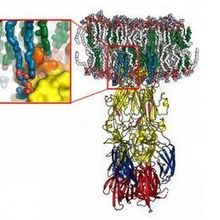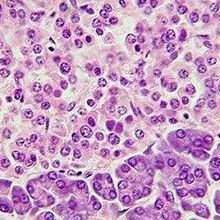Login
Subscribemembrane proteins

Amyloid Precursor Protein Linked to Brain Development Mechanisms
Catherine Offord | Dec 1, 2021 | 2 min read
Researchers provide evidence that the Alzheimer’s-associated protein calibrates a signaling pathway that is conserved across the animal kingdom.

Cellular Biologist Michael Mueckler Dies at 67
Lisa Winter | Aug 18, 2021 | 1 min read
His work centered on the mechanisms of glucose transport into cells.

An Introduction to Glycoproteins
Rebecca Roberts, PhD | 5 min read
Making up the majority of all eukaryotic proteins, glycoproteins have a wide range of important physiological roles, from cell-cell signaling to disease pathogenesis.

Image of the Day: Amoeba Nibbles
Chia-Yi Hou | May 2, 2019 | 1 min read
A pathogenic amoeba species ingests parts of human cells and steals human cell membrane proteins to display on its own surface.

New Technologies Shed Light on Caveolae
Ben Nichols | Jun 1, 2018 | 10+ min read
The functions of the cellular invaginations identified more than half a century ago are now beginning to be understood in detail.

Streamlining Membrane Protein Research with Mass Photometry
The Scientist and Refeyn | 3 min read
Mass photometry advances membrane protein characterization by offering fast and precise mass measurements of samples containing membrane mimetics.

Infographic: Caveolae Form and Function
Ben Nichols | May 31, 2018 | 1 min read
Researchers interrogate the cavernous structures on the surface of cells to better understand how they affect membrane function.

Researchers Produce Alpaca Antibodies Using Yeast
Catherine Offord | Feb 13, 2018 | 2 min read
With multiple applications in biomedicine, the antibodies can now be made quickly, cheaply, and without the need for an alpaca or one of its relatives.

Measuring Membrane Proteins with Mass-Sensitive Particle Tracking
The Scientist Creative Services Team in collaboration with Refeyn | 2 min read
Researchers will discuss a new mass photometry method that characterizes molecules in their native state on supported lipid bilayers.

Image of the Day: Membrane Fever
The Scientist and The Scientist Staff | Nov 17, 2017 | 1 min read
Scientists have discovered a mechanism by which the Rift Valley fever virus infects the cells of its hosts.

Pushing Boundaries
Anna Azvolinsky | Dec 1, 2016 | 8 min read
Applying physics, chemistry, and cell biology, Satyajit Mayor seeks to understand how cell membranes work.

Identifying Antibodies that Target Membrane Proteins in Their Native Conformations
The Scientist Creative Services Team in collaboration with OXGENE | 2 min read
A new mammalian display platform enhances antibody discovery for challenging protein targets.

Video: Cells, Skin Deep
The Scientist | Nov 30, 2016 | 1 min read
Profilee Satyajit Mayor discusses his explorations of cell membranes, which are helping to update the classical fluid mosaic model of dynamic cellular boundaries.

Crystal Structure, Murky Function
Ruth Williams | Jan 29, 2015 | 3 min read
Scientists have determined the crystal structures of bacterial translocator proteins, but their functions remain unclear.

Key Osmotic Channel Protein Identified
Rina Shaikh-Lesko | Apr 10, 2014 | 3 min read
A little-studied protein appears to be a critical part of the perplexing channel that prevents cells from bursting.

Protein Zippers
Jef Akst | Jun 1, 2013 | 2 min read
Matching up positive and negative charges on two of its subunits may allow the TatA membrane transporter to penetrate the lipid bilayer.

Synthetic Peptide Fools Immune System
Dan Cossins | Feb 21, 2013 | 3 min read
Researchers have created a molecule that helps nanoparticles evade immune attack and could improve drug delivery.
Plant RNAs Found in Mammals
Cristina Luiggi | Sep 20, 2011 | 3 min read
MicroRNAs from plants accumulate in mammalian blood and tissues, where they can regulate gene expression.
How Vampire Bats Find Veins
Jessica P. Johnson | Aug 4, 2011 | 3 min read
Heat-sensing protein channels in vampire bats allow the flying mammals to find the best place to sink their teeth into their prey.
